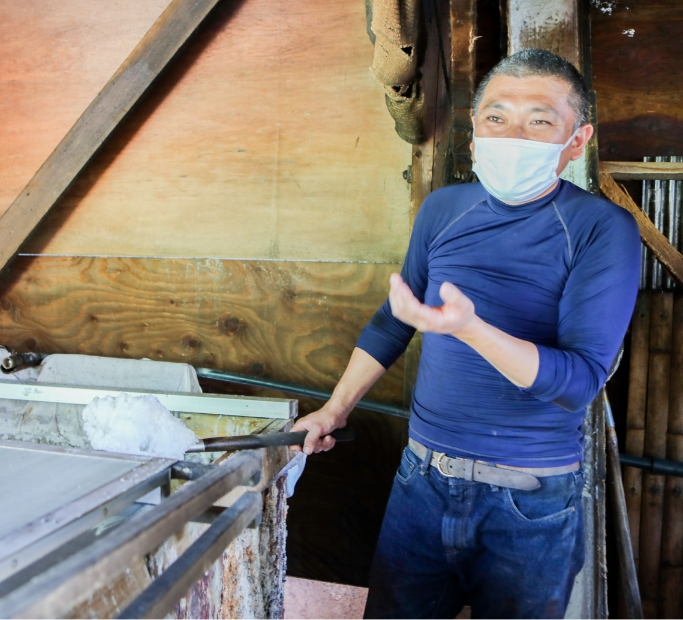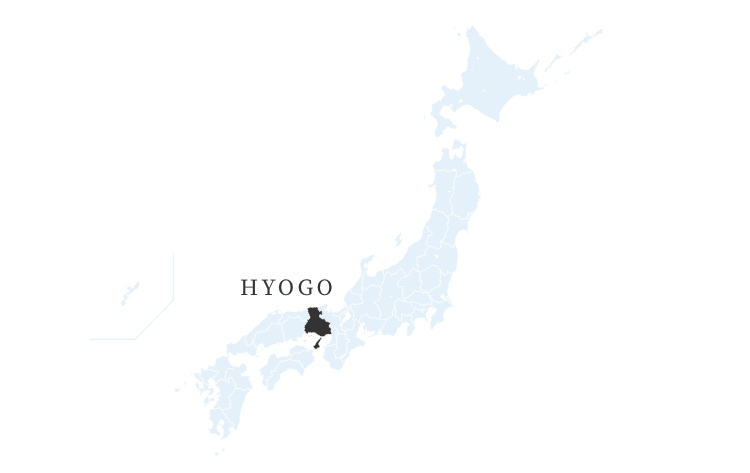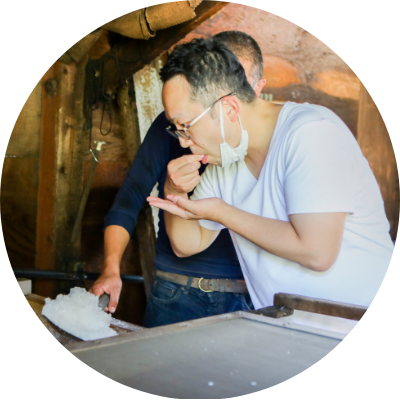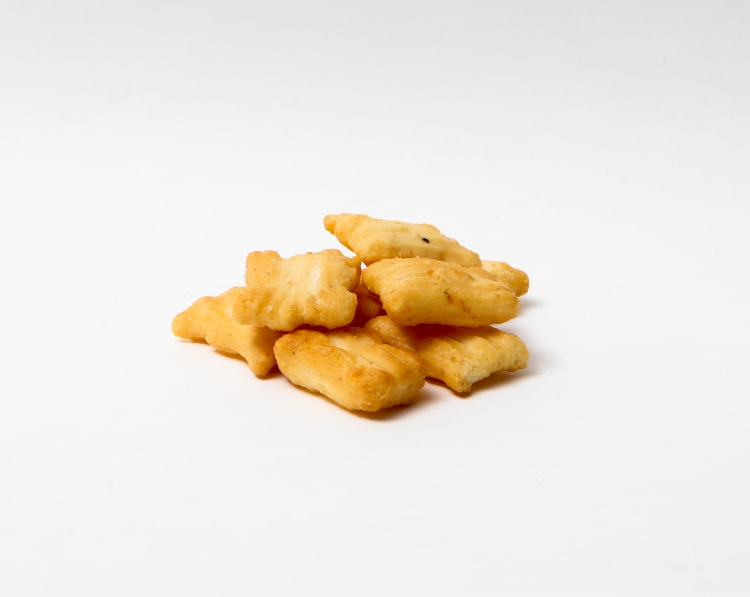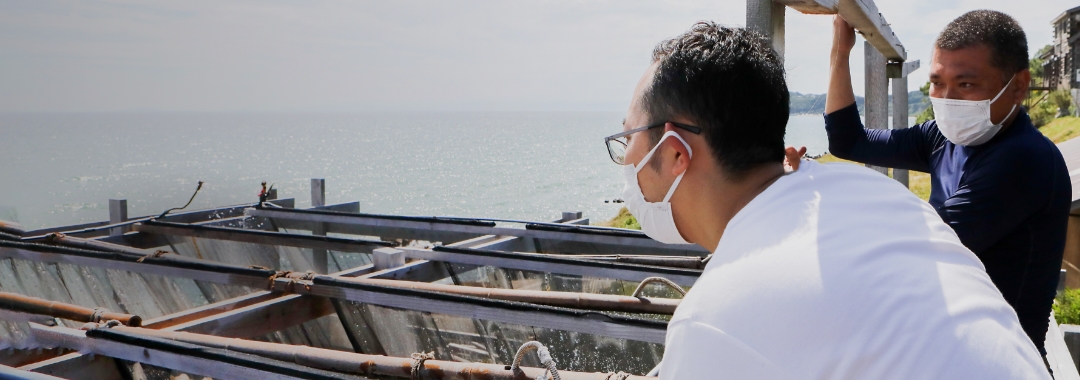Salt Making Invoking the Origins of Life
Mr. Suezawa’s salt-works are located on the west coast of Awaji Island, where you can see beautiful sunsets. He scoured both Kobe and Akou in search of suitable land for salt production; in 2012 fate brought him to this place.
「I was always attracted to the idea of “shin-do-fuji” (the teaching that a person’s body is created in the land where they live), so I wanted to start salt production in Hyogo Prefecture, where I’m from. I looked everywhere but couldn’t find a suitable place, so I finally came to Awaji Island. And one day I approached an old lady in front of the shrine here, she was the landowner and agreed to let me use this place.」
The quality of the salt is all about the quality of the water; especially where it’s sourced. To realize Mr. Suezawa’s ideal salt he, naturally, needed to be near the sea but it was also important to be close to the mountains and the rivers that bring rainwater, enriched with minerals from the land, to the sea. However, too close to the rivers and the water would be too brackish (where seawater and freshwater mix). It is now ten years since he found the ideal location that meets the right conditions for his salt production.
Mr. Suezawa initially worked in business development for food and beverage outlets, and was on the verge of owning his own shop. However, one day he had an experience that brought back to him the importance of the basics of ‘eating’ and ‘living’, and he realized the significance of water and salt anew.
「For three or four years after I decided I wanted to make a living from salt, I traveled around the country visiting people who were making natural salt on a small scale and learning from them. What I am doing now is my own hybrid of what I learnt from those experiences. I don’t need to make a lot of money, but I want to make a living by continuing to make things with my own hands, creating something that makes people happy.」
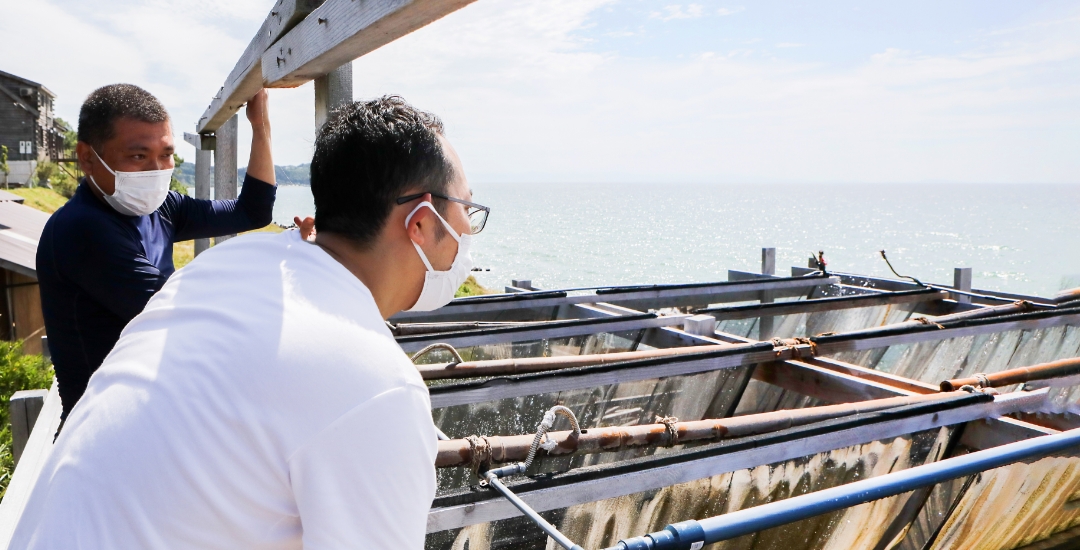
Nutrient-rich Seawater, Pumped at High Tide and Diligently Reduced
Mr. Suezawa’s process for making Onokoro Shizuku salt begins with collecting seawater at high tide as minerals rise from the sea floor. The seawater is first passed through a microfilter to remove impurities, such as microplastics, and then a device called a ‘reverse osmosis membrane’ to increase the salt concentration to around 6-7%. This process reduces the time the brine will then need to be exposed to the sun. Mr. Suezawa says this is because the longer seawater is exposed to the sun, the more likely minerals are lost.
「Japan’s climate is too humid and rainy [to form rock salt]. It is one of the few countries in the world where seawater is boiled down to make salt. Seawater contains mainly sodium chloride but also as many as 80 other trace elements, but rock salt is crystallized salt from the sea from a long time ago, so most of these minerals have disappeared.」
Seawater condensed using the ‘reverse osmosis membrane’ is now ready to be further concentrated by evaporation in the sun and the wind. Using a gravity based ‘flow-down system’ the seawater trickles down zigzagging sails, becoming more concentrated. The brine is collected and returned to the top again to concentrate further. This cyclical process is repeated for two to four weeks until it becomes sufficiently salty. It is only after this point that it is finally ready for the boiling process.
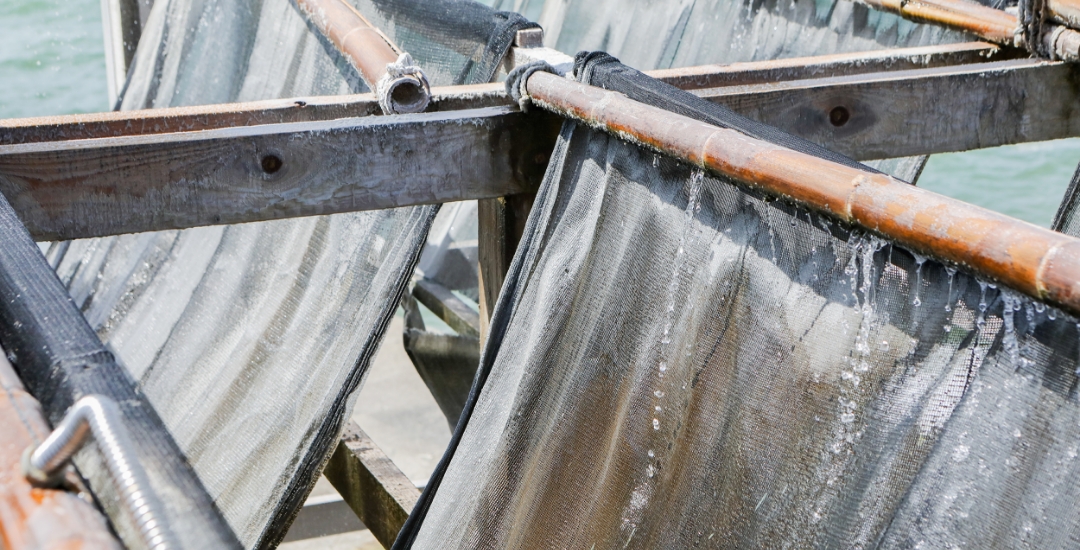 Seawater condensed using the ‘reverse osmosis membrane’ is now ready to be further concentrated by evaporation in the sun and the wind.
Seawater condensed using the ‘reverse osmosis membrane’ is now ready to be further concentrated by evaporation in the sun and the wind. Salt Inspired by the Memory of Ancient Seawater in the Human Body
Mr. Suezawa uses firewood and traditional iron kettles to boil seawater. First, the water is reduced in a Futtō-gama (a ‘Boiling Kettle’) for about 30 hours without a lid. Next, it is transferred to a Shiage-gama (a ‘Finishing Kettle’), heated by glowing embers, for a further 30 hours to crystallize the salt and refine the grain texture. All of these processes were developed to achieve Mr. Suezawa’s ‘ideal salt’. To help decide the amount of minerals and bittern that should be retained, ‘ancient seawater’ is used as a reference to find the best balance between nutrition and flavor.
「They say people have an ocean inside them. It is said that the salt concentration that people find tastiest is 0.8%, which is much lower than current seawater. This salinity is, actually, the same as that of our blood, our mother’s amniotic fluid, and the salinity of the sea when plankton was born a long time ago. So in our salt production, we hope to recreate the ancient sea in our bodies. For example, ancient seawater was rich in iron, but today’s seawater does not contain much. The reason we use iron kettles is to compensate for that iron.」
It’s incredible to think that Mr. Suezawa is striving to produce mineral-rich salt in the image of ancient seawater from hundreds of millions of years ago. Even more astonishing is the fact that the shape of salt crystals vary according to temperature, production method, and place of origin. During our visit we were presented with beautiful sparkling crystals of Onokoro Shizuku salt shaped like pyramids, something we had never seen before. We all became captivated by the wonder of salt!
Freshly formed salt is packed into cedar barrels and left to rest for 24hours before being sieved to a grain size of 2 mm. This grain size is the optimum solution that Mr. Suezawa arrived at through trial and error. These slightly larger grains dissolve more slowly on the tongue, so the saltiness spreads gently, without harshness.
「Salt is so interesting, you think you’re doing the same thing every time, but the results are always slightly different. You just can’t beat nature. I used to be a ‘brown rice vegetarian’ and was very strict about what I ate. Now, rather than narrowing my choices by saying this is bad or that is bad, I want to focus on being in a good mood every day. I started to think this way after I came to Awaji Island.」
The gaze of Mr. Suezawa is warm, generous and straightforward; reflecting the taste of his salt.


